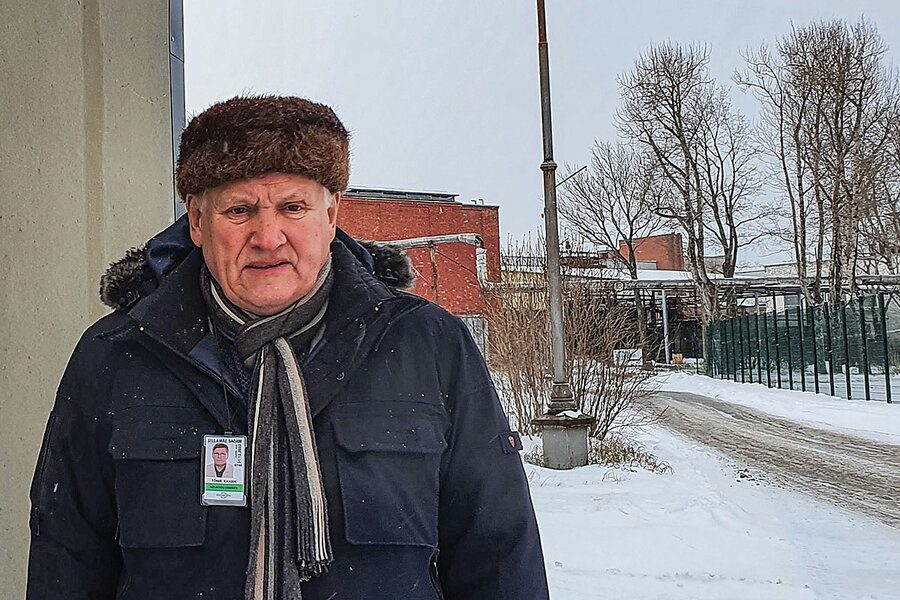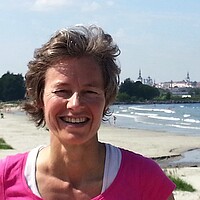A secret town’s renewal, from radioactive cleanup to recycling jobs
Loading...
| SILLAMÄE, ESTONIA
As a government inspector for the Soviets, Tõnis Kaasik witnessed the lack of environmental care in a region tasked with supplying the USSR’s nuclear arsenal with enriched uranium. When the regime collapsed, Mr. Kaasik became Estonia’s first environmental minister, and with the help of the international community began to contain the waste hazard that threatened the Baltic Sea.
“Estonia wasn’t a member of NATO yet but really wanted to be,” says Cheryl Rofer, a nuclear researcher. “Tõnis felt strongly … about Estonia and wanted it to be a better place.”
Why We Wrote This
Tõnis Kaasik was Estonia’s first environment minister after the USSR collapsed. A sense of duty, including to the Russians left behind by the Soviets, keeps him creating opportunities for the region’s people.
Yet his concern reached beyond the Ida-Virumaa region’s environment. For years, it was looked down upon as a Russian-speaking enclave suspected of being closer to Moscow than to Tallinn. In Sillamäe, former uranium workers, who spoke only Russian, were highly skilled but unemployed. Mr. Kaasik reconverted uranium facilities to bring his battery recycling business online in 2003, seeing it as his chance to turn waste into something useful and create jobs.
His newer project is renovating an old seaside mansion into a hotel complex, which also employs dozens of locals. Says Eva Ambus, one of the first employees at Saka Manor, “Tõnis has injected new life into Ida-Virumaa.”
In bone-chilling wind, Tõnis Kaasik makes his way through a maze of blackened red brick facades, metal pipes, and old chimneys to visit his staff at EcoMetal, the battery recycling company he carved out of an old Soviet uranium refinery that once fueled the USSR’s nuclear weapons arsenal.
In the distance, smoke billows from Soviet-era power and chemical plants, forming deep clouds above the chilly Baltic seashore. Used batteries arrive here at the European Union’s easternmost commercial port, which receives natural gas container ships as a major connecting point between Russia and Europe.
For years, this now-important industrial town was shrouded in mystery, reeling from its past as a secret uranium enrichment city. By the time the USSR collapsed, a major Soviet industrial capital had become a radioactive depository with a large, unemployed, mostly Russian-speaking population. But Tõnis Kaasik – environmental activist, Estonia’s first minister of the environment, and a green entrepreneur – gave the region, and its people, a new lease on life.
Why We Wrote This
Tõnis Kaasik was Estonia’s first environment minister after the USSR collapsed. A sense of duty, including to the Russians left behind by the Soviets, keeps him creating opportunities for the region’s people.
Drawn to the Ida-Virumaa region’s cliffs and waterfalls as a geography student more than 50 years ago, Mr. Kaasik stayed as the Soviet regime made him an environmental inspector in charge of the forest in Estonia’s northeast. He witnessed the lack of environmental care that poisoned his country’s soil and soul, and decided to dedicate his life to helping it heal.
In independent Estonia he spearheaded the effort to rid Sillamäe of its radioactive legacy, guided by a “great sense of ‘the Soviets did this terrible thing to our country, and we would really like to heal those wounds,’” says Cheryl Rofer, a retired chemist from Los Alamos National Laboratory in New Mexico, whom Mr. Kaasik invited to the radioactive site in Sillamäe in 1998. She was instrumental in helping to get NATO to participate in its remediation.
Oil shale and later, uranium
Before war broke out in Ukraine, Estonia had pledged to stop producing electricity from shale oil by 2035. Ida-Virumaa’s rich oil shale deposits make the country nearly the highest per capita carbon emitter in Europe. Moscow once imported its best minds to work on the big shale-powered plants it built here. “The end products and the money went back to the Soviet Union; the environmental legacy stayed here,” Mr. Kaasik says. The industry had polluted the groundwater, decimated forests, and scarred the landscape with myriad “waste hills.”
After discovering that uranium could be extracted from the rock on the Ida-Virumaa coast, the Soviets built a top-secret city dedicated to processing the ore. By the 1990s an estimated 100,000 metric tons of uranium had been produced in Sillamäe, used in the manufacturing of 70,000 nuclear weapons. The place was never to be entered or left without approval. Nobody was allowed to know what happened there, “but I knew,” says Mr. Kaasik.
With the greater freedoms of Mikhail Gorbachev’s glasnost and perestroika, Mr. Kaasik took part in the successful 1987 protest movement to ban the opening of a new phosphorus mine, an event seen as helping to foster the dissolution of the Soviet government in Estonia. Only after Estonia gained independence in 1991 did the world discover Sillamäe’s secret past. Mr. Kaasik, as the first Estonian environment minister, had to deal with the legacy.
“There are problems linked to uranium mining all over the world, but Sillamäe may be one of the biggest,” remembers Ms. Rofer, a former nuclear-disarmament specialist who has led environmental cleanup projects worldwide, from Los Alamos to Kazakhstan. In Sillamäe, “there was a kilometer-long, half-a-kilometer-wide pile of tailings from what must have been 50 years of processing a variety of material, all of them having some radioactive material,” says Ms. Rofer. The waste was only yards from the sea; waves and rain could have washed off radioactive material into the ocean, toward Finland.
“There was all this waste left and my task was to cover this dump, make it secure,” says Mr. Kaasik. “That took 11 years and cost €28 million.” The international community, including the European Union, helped.
Ms. Rofer remembers Mr. Kaasik’s eagerness to gain NATO support. “Estonia wasn’t a member of NATO yet but really wanted to be,” she says. “Tõnis felt strongly about the dangers that the waste pond represented, and he felt strongly about Estonia and wanted it to be a better place.”
The remediation also paved the way for Sillamäe’s economic recovery. By 2003, with the radioactive waste turned into a gigantic green hill, the local harbor, which the Soviet military had bombed in the 1960s, could be rebuilt. Although the war in Ukraine and sanctions against Russia are widely expected to deal an economic blow to the region, the port had helped Sillamäe regain its position as a commercial bridge between the East and the West. “It was a must to solve this problem,” says Mr. Kaasik. “If it is not clean, nobody comes.”
“Now I had to think about what to do next,” Mr. Kaasik says.
Some workers were producing rare earth metals at the old plant, but Sillamäe was hurting. Former uranium workers, who spoke only Russian, were highly skilled but unemployed. Mr. Kaasik felt compelled to help. “The work had to be related to previous industrial work,” he says. Mr. Kaasik reconverted old uranium facilities to bring EcoMetal online in 2003, seeing it as his chance to turn waste into something useful. EcoMetal recycled 20,000 tons of batteries last year, producing 12,000 tons of lead and lead alloys.
Aleksandr Arhipov was 21 years old when he was uprooted from his native Tomsk in Siberia to work in Sillamäe. He saw his world collapse two decades later in 1990 when he went from being a Soviet citizen to being the former occupier, part of a group that was often mistrusted and hated by Estonians. “It was bad,” he recalls.
Mr. Kaasik hired Mr. Arhipov and 60 other ex-uranium workers. The job gradually gave him stability, and enabled him to surmount the trauma of Estonian independence. He says he has found his place as a full-fledged, Russian-speaking Estonian.
For many years, Estonia’s industrial northeast was looked down upon as a Russian-speaking enclave suspected of being closer to Moscow than to Tallinn. In the wake of Moscow’s 2014 annexation of Crimea, fear of the Kremlin using its Russian minorities to destabilize the West brought attention to Ida-Virumaa. Stability in the Russian-speaking region continues to be important in light of the war Russia is waging in Ukraine.
“Sillamäe is becoming normal,” says Mr. Kaasik. In Estonia, “there are Russian-speaking and Estonian-speaking Europeans.”
From Soviet barracks to mansion hotel
In 1971, Mr. Kaasik was a student measuring a 23-meter waterfall in Ida-Virumaa when a Soviet border guard arrested him, thinking he was a spy. The military barracks he was taken to was a 17th-century mansion with stunning views of the Baltic Sea. The historic home deserved better, he remembers thinking. One day, he told himself, he would restore it, so people could discover the region’s nature and history.
Just before EcoMetal took off, in 2001 Mr. Kaasik saw an ad in the newspaper: Saka, the manor he’d once been a prisoner in, was being auctioned off by the government. He bought it and has been renovating it one room at a time, yet another way of fulfilling his pledge to help Ida-Virumaa heal. More than 30 locals have jobs at the manor, a working hotel complex that is stimulating other economic development.
“Tõnis has injected new life into Ida-Virumaa,” says Eva Ambus, one of the first locals hired at Saka Manor. At first, when she couldn’t afford a car, Mr. Kaasik paid for her 27-mile round-trip commute by taxi, making it possible for her and many other employees to work in a struggling region with little public transportation. Ms. Ambus took a different job last year but is considering a return to her old one. “I miss Saka very much,” she says.
Renovating the manor is expensive. But closing it, even in the pandemic when visitors have been sparse, is out of the question.
“I have no choice,” says Mr. Kaasik.“I feel some responsibility.”









